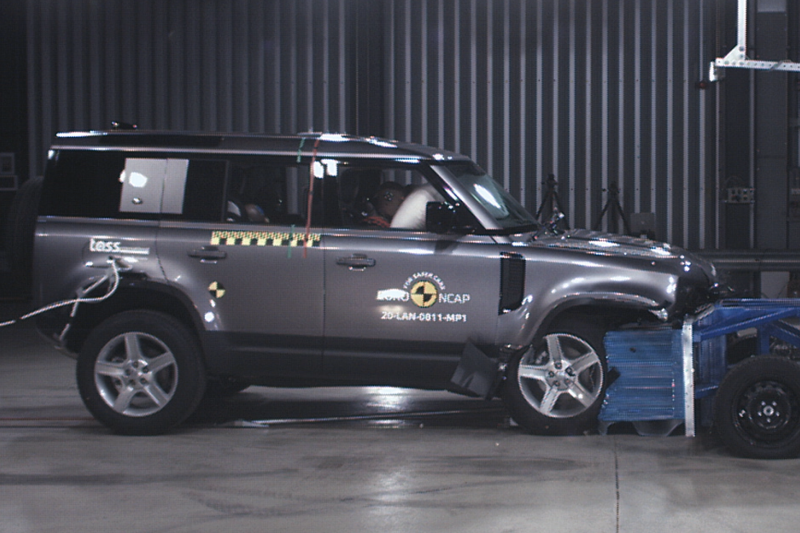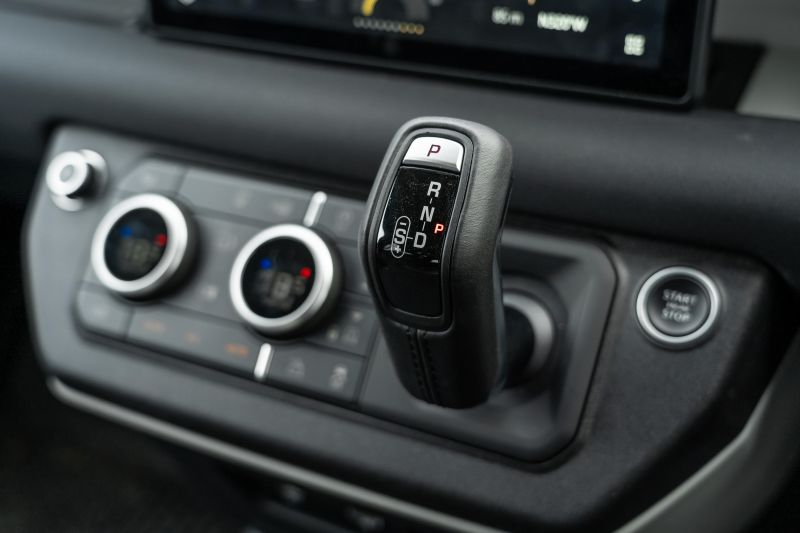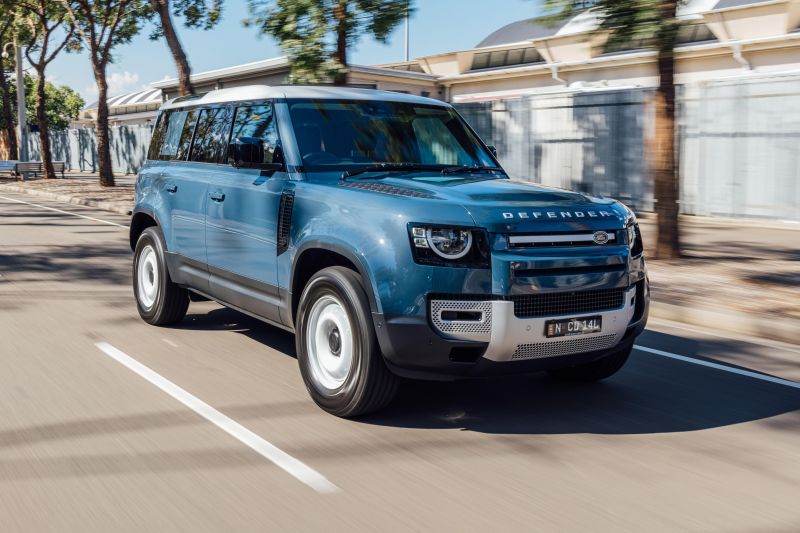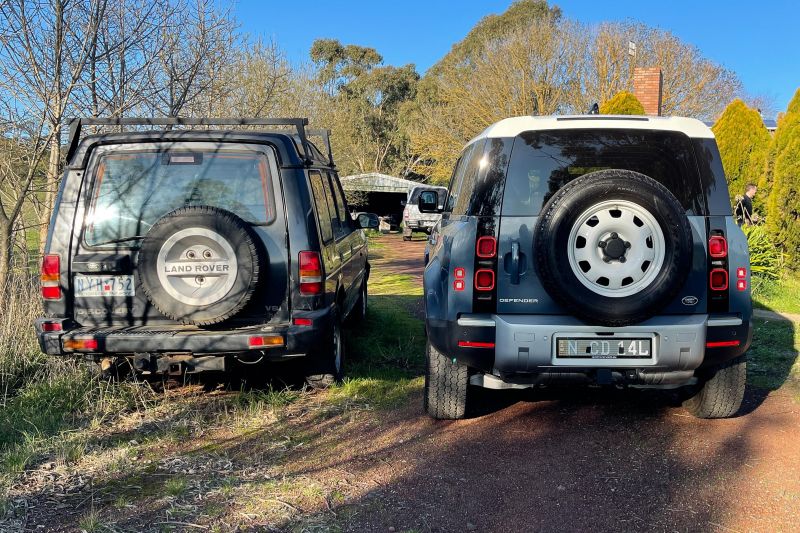It’s not every day you get to meet an icon.
The Land Rover Defender is one of the automotive legends, an OG. Its mere existence in 2021, even if it’s a very modernised take, is a miracle.
As a boy I remember a Defender reboot being talked about for years, even while the decades-old previous model continued to live on. Similar scuttlebutt swirled during my early years as an automotive journalist – so it’s been a long time coming.
Finally, at the 2019 Frankfurt motor show, Land Rover revealed its all-new Defender. It captured the industry, polarised opinion – it was basically the automotive equivalent of Kim Kardashian ‘breaking the internet’.
Fast forward to now, and there’s three-door ’90’ and five-door ‘110’ versions of the Defender on sale in Australia, with an even bigger ‘130’ in the works.
While Land Rover has had to bring the Defender into the 21st Century, it’s done a lot to acknowledge the nameplate’s heritage and character.
You can imagine my delight when I first laid eyes on this Tasman Blue Defender D250 S press car, complete with a contrast white roof and retro-cool white steelies.
Can the modernised Defender cut it as a daily driver, with the added bonus of rugged off-road ability for the weekend escape? Let’s find out.

How much does the Land Rover Defender 110 D250 S cost?
On test we have the 2021 Land Rover Defender 110 D250 S, which starts at $91,220 before on-road costs. It’s third up the price ladder.
See the full 2022 Land Rover Defender 110 price list below:
- 2022 Land Rover Defender 110 P300: $76,960
- 2022 Land Rover Defender 110 D250: $82,590
- 2022 Land Rover Defender 110 D250 S: $91,220
- 2022 Land Rover Defender 110 P400 S: $92,360
- 2022 Land Rover Defender 110 D300 SE: $96,780
- 2022 Land Rover Defender 110 P400 SE: $103,800
- 2022 Land Rover Defender 110 P400 XS Edition: $113,580
- 2022 Land Rover Defender 110 D300 X-Dynamic HSE: $113,980
- 2022 Land Rover Defender 110 P400 X-Dynamic HSE: $120,480
- 2022 Land Rover Defender 110 D300 X: $143,190
- 2022 Land Rover Defender 110 P400 X: $145,290
- 2022 Land Rover Defender 110 P525 V8: $205,500
All prices exclude on-road costs
Given the wide spread of variants and price brackets, pin-pointing the Defender’s competitive set largely depends on the model you choose, as well as your intended use.
You could logically cross-shop the Defender with everything from the Audi Q7, BMW X5, Mercedes-Benz GLE and Volkswagen Touareg to the Jeep Wrangler, Mercedes-Benz G-Wagen and Toyota LandCruiser.
Even within Land Rover’s own stable, the Defender is a more rugged alternative to the likes of the Discovery and Range Rover Sport. The choice is endless really.
Our test vehicle also had about $20,000 worth of options fitted, including:
- Canvas folding roof: $4810
- Advanced Off-Road Capability Plus Pack: $2210
- Terrain Response 2
- All Terrain Progress Control
- Configurable Terrain Response
- White painted roof: $2171
- Tasman Blue Metallic paint: $2060
- Front jump seat: $1853
- Tow hitch receiver: $1432
- Air Suspension Pack: $1309
- Electronic Air Suspension
- Adaptive Dynamics
- Automatic headlight levelling
- Clearsight rear-view mirror camera system: $1274
- Privacy glass: $999
- Leisure Activity Key: $910
- Electronic Active Differential with torque vectoring by braking: $806
- Heated front seats: $806
- 18-inch 10-spoke steel wheels in Sparkle White: $NCO
- 18-inch steel full-size spare wheel: $NCO
All up, the vehicle you see here is $111,860 plus on-road costs.
What do you get?
Standard equipment on the Defender S includes:
- Leather-wrapped steering wheel and shifter
- Automatic high beam
- Digital instrument cluster
- 12-way partially powered front seats
- 19-inch alloy wheels
- Folding rear centre armrest (folding)
- Interactive Driver Display (digital instruments)
That’s on top of the following base specification:
- 10.0-inch touchscreen infotainment system
- Android Auto/Apple CarPlay (wired)
- DAB digital radio
- Terrain Response
- Keyless entry/start
- LED headlights
- Tyre-pressure monitoring
- Hill descent control
- Hill launch assist
- Automatic headlights
- Rain-sensing wipers
- Dual-zone climate control
- Partial leather upholstery
- Eight-way partially powered front seats
- Rubber cabin and boot flooring
- Electric parking brake
- Heated electric side mirrors with auto-dimming and approach lights
- 18-inch alloy wheels
- Full-size spare wheel
Is the Land Rover Defender 110 D250 S safe?
The Land Rover Defender 110 wears a five-star ANCAP safety rating based on tests conducted in 2020 by Euro NCAP.
The Defender range received scores of 85 per cent for adult occupant protection, 88 per cent for child occupant protection, 71 per cent for vulnerable road user protection, and 76 per cent for safety assist.
All models come standard with the following safety equipment:
- Autonomous emergency braking
- Blind-spot monitoring
- Lane-keep assist
- Rear cross-traffic alert
- Adaptive cruise control
- Driver attention monitoring
- Surround-view camera system
- Front/rear parking sensors
- Safe exit alert
- Traffic sign recognition
Dual frontal, front-side for the first row and side curtain airbags for both the first, second and optional third row are also standard.
What is the Land Rover Defender 110 D250 S like on the inside?
If you’ve read one of our previous Defender reviews, there’s no surprises here.
Compared to the more plush Discovery and even plusher Range Rover Sport, the Defender takes a utilitarian, rugged approach to cabin design and materials.
There’s exposed screws, a powder-coated crossbeam, and chunky switchgear that’s quite unique while also ensuring a sense of durability.
Mix that with the padded trimmings dotted throughout the cabin, the leather-trimmed steering wheel and combination upholstery, and it’s a mish-mash of materials and textures that not only look cool but also feel worthy of the asking price.
At the centre of the dashboard is Land Rover’s latest Pivi Pro system, seen here in standard 10.0-inch guise. The larger 11.4-inch display – which I’m obsessed with from my time with the Jaguar F-Pace SVR – is a $210 option.
Regardless of the display size you choose, it’s a marked improvement over JLR interfaces of old. Resolution is crisp, response times are snappy, and there’s a level of polish befitting a premium brand.
If you don’t want to use the native software or built-in satellite navigation, you can wire in your smartphone via Apple CarPlay or Android Auto. While it’s not wireless, it worked seamlessly during our time with the Defender, and both USB-A and USB-C inputs are supported.
What wasn’t quite as good was audio quality. Our test vehicle was running the standard unbranded sound system with six speakers, which just didn’t have a high-end feel to the sound. One of the speakers in the rear also started rattling with music playing.
If it were me, I’d be ticking the option box for one of the available Meridian sound systems. Speaking of options, I could probably do without the optional ClearSight digital rear-view mirror – its viewing angle is very high and lower-riding vehicles disappear under the lower border.
Storage and space, meanwhile, are pretty abundant. The upright windscreen, high roofline and lack of centre console in our tester – courtesy of the optional jump seat – meant the front row feels open and spacious.
There’s a selection of cubbies, nooks and crannies to stow phones, wallets, keys, snacks, you name it. It’s certainly practical, and the jump seat reveals cup holders and a tray when folded.
I’d prefer to option the Defender 110 with a third row of seating and keep the standard front centre console. The jump seat is best left for kids given the high hump in the floor and limited shoulder room.
The folded centre seat up front also is high-set and lacks the deep console storage available with the standard setup.
I took five friends with me on a trip to Kilmore before lockdown and having a taller adult in the front-centre seat was just a pain.
Second-row space is also very good. I comfortably can sit behind my own driving position, and three across would be much more comfortable than up front.
Outward visibility for kids is excellent thanks to the tall windows, and there’s amenities like directional air vents, fold-out map pockets, a fold-down centre armrest, and small bottle holders in the doors.
As for the boot, Land Rover quotes the five-seat Defender 110 offers 972L to the headliner behind the second row, expanding to 2277L with the second row folded. Opting for the extra row of seating reduces those figures slightly (916L/2233L).
The boot floor is finished in a hard-wearing, patterned material that should be able to be easily wiped down if you’re carrying muddy equipment or clothes, and there’s switches to raise and lower the rear suspension for easier access.
Under the boot floor there’s added storage as well as tools for the boot-mounted spare wheel.
What’s under the bonnet?
The Defender D250 is powered by a 3.0-litre inline six twin-turbo diesel with 48V mild-hybrid assistance, hooked up to an eight-speed ZF automatic and full-time all-wheel drive with low-range gearing.
Outputs for the D250 tune are quoted at 183kW (4000rpm) and 570Nm (1250-2250rpm), with 0-100 taking a claimed 8.3 seconds on its way to a top speed of 188km/h. Fuel consumption for the Defender 110 D250 is quoted at 7.9L/100km on the combined cycle.
There’s also a beefier D300 version (220kW/650Nm) available, while the three-door Defender 90 also offers a lower-spec D200 (147kW/500Nm) tune.
In terms of how it compares to rivals, the significantly more expensive Mercedes-Benz G400d also uses a 3.0-litre inline six turbo-diesel, though it’s punchier with quoted outputs of 243kW and 700Nm, making it more of a match for the D300-spec Defender.
The 4.5-litre V8 diesel in the retro Toyota LandCruiser 70 Series makes a paltry 151kW and 430Nm by comparison, while the soon-to-be-replaced LandCruiser 200 Series makes 200kW and 650Nm from its twin-turbo 4.5-litre diesel.
Later this year we’ll see the introduction of the LandCruiser 300 Series, which gets a new 3.3-litre twin-turbo V6 diesel with 227kW, 700Nm and a trick 10-speed auto.
How does the Land Rover Defender 110 D250 S drive?
If you’re expecting the drive experience of the new Defender to be a throwback like much of the aesthetics, boy are you in for a surprise.
Within a few hundred metres of wheel time after picking it up, I was so pleasantly surprised at how much the Defender drives more like a Range Rover.
The 3.0-litre turbo-diesel inline six even in this weaker D250 tune is silky smooth and effortless in delivery, working well with the smart-shifting eight-speed auto.
Most of my time in the Defender was spent in the city and suburbs or the highway and, despite its size and height, I found driving to and from work pretty easy.
The air suspension is cushy without being wallowy, and combined with the thick tyre sidewalls of our tester it delivers a wafty ride that puts many luxury SUVs to shame.
Pot holes, tram lines, and road joints barely make themselves known in the cabin, and at higher speeds broken surfaces and undulations are handled with finesse.
Light (yet accurate) steering and good visibility courtesy of the plentiful glasshouse and surround cameras also make the Defender wieldy in town and not too hard to park – though its immense size means most spots are a squeeze.
Refinement is also impressive at all speeds, with road and wind noise kept to a relative minimum, though you will hear echoes through the optional fabric roof in tunnels and under bridges – I’d personally go without this feature.
You may also hear some wind whistle off the upright windscreen and blocky mirrors, though it’s never at an uncomfortable levels.
As mentioned earlier performance from the 3.0-litre inline-six diesel is super refined, with an almost lazy, effortless character no doubt aided by max torque being on tap from just 1250rpm.
It never gets too loud or unrefined under hard acceleration, and at a cruise in seventh or eighth it’s near silent in the background.
Land Rover has fitted the bulk of its driver assistance systems as standard across the Defender line-up in Australia, which is a good move. Adaptive cruise control is intuitive, although like all JLR products it only moves in 2km/h increments, and the lane-keep assist system isn’t as smart as some of the more autonomous-capable lane centring systems now available.
With that said, everything works as intended.
Unfortunately I didn’t take the Defender off-road, though we’ve now sampled both 90 and 110 versions of the rugged Land Rover off the beaten track and determined it’s more than capable of tackling what most owners could ever throw at it.
In addition to the adjustable air suspension (which can raise the ride height to a dizzying 291mm), the Defender comes standard with the basic Terrain Response system that tailors the 4×4 system and electronic aids to suit different surfaces, as well as hill descent control, hill launch assist, and low-range gearing.
Watch our video review for a closer look.
How much does the Land Rover Defender 110 D250 S cost to run?
Land Rover has permanently moved to a five-year, unlimited-kilometre warranty.
Land Rover offers a five-year/102,000km servicing plan for the Defender range. For all diesel models and the P400, it’s priced at $2650. The P300 is cheaper at $1950, while the P575 V8 is more expensive at $3750.
In terms of real-world fuel consumption, we saw an indicated 9.5L/100km over 560km of mixed driving during our week of testing. While that’s quite a bit up on Land Rover’s 7.9L/100km claim, keep in mind this 2347kg (kerb) off-roader did a week’s worth of peak-hour commuting as well as some extended freeway stints.
The 89L fuel tank means that you can easily expect between 800 and 1000km between fills depending on driving conditions, less with more city driving and more with a skew to highway touring.
CarExpert’s Take on the Land Rover Defender 110 D250 S
There’s no question of the Defender’s status as an icon, and this modern interpretation of Land Rover’s staple is an excellent blend of old- and new-school.
Sure, it may present as more of a spiritual successor to the original Discovery (see for yourself below), but given we live in an age where electrification and active safety is so prevalent, yours truly thinks it’s a very impressive vehicle as a whole.
It’s comfortable, refined, tech-laden, and looks the goods. Not much else at this end of the market competes, and you can have two Defenders like the one you see here for the price of a similarly-engined Mercedes-Benz G400d.
Most buyers will likely never use its full off-road capabilities, but isn’t that the case with most SUVs anyway? At least, unlike the Suzuki Jimny and Jeep Wrangler, the Defender makes sense as a practical, luxurious family hauler.
Does it cut it as a daily driver with weekend adventure capability? You bet.
Click the images for the full gallery

































